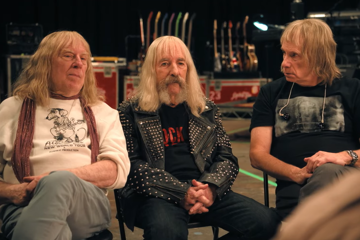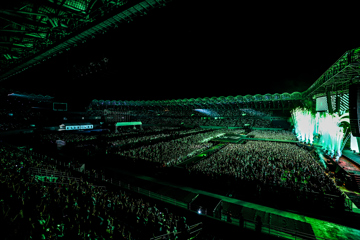Mr Burns: A Post-Electric Play (Belvoir)
"A melding of pop culture, high art, religious omens and the evolution of myth."

Mr Burns: A Post-Electric Play is a strange and marvellous mishmash of high-brow and low-brow, with plenty of meaning and nuance to be teased from within.
The Australian premiere of Anne Washburn’s theatrical meta-piece, devised and first staged off-off-Broadway less than a decade ago, arrives on the Sydney stage via Adelaide thanks to a joint effort by Belvoir and the State Theatre Company of South Australia. Mr Burns comes bundled with a lot of hype, yet going in, audiences may well be better off going in knowing less rather than more.
However, die-hard fans of the four-fingered family should bear one thing in mind: if you arrive expecting a pitch-perfect love letter to The Simpsons, you may be disappointed. Rather, this is a play about people and how they adore and interact with The Simpsons, how its meaning to them changes in a post-apocalyptic world — or at least it begins as one, the ideas explored in this play are greater than the sum of its parts.
Those parts being three acts. In the first, we are introduced to a rag-tag group of survivors and the repercussions of a campfire conversation in which they find solace and joy in attempting to piece together a Simpsons episode from memory alone. Through leaked morsels of information, we learn that society as we know it has been brought down by a mass failure of the power grid and subsequent fires, radiation leaks and generalised havoc. Several years after said conversation, in Act 2, we find them as a sort of travelling performance troupe re-enacting Simpsons episodes (complete with bastardised commercials), facing staunch competition against rival Simpsons recreationists (as each troupe barters for crowd-sourced recollections of lines and scenes from iconic episodes) and other speciality companies (including “the Shakespeares”).
A The Walking Dead-esque sense of naturalism gives way to joyful bizarreness as the group rehearse their scenes clad in scrappy, outlandish costumes of Simpsons characters complete with bulbous eyes and yellow rubber gloves. Jonathan Oxlade’s set and costume designs marry the bleak with the bold seamlessly, and Imara Savage’s direction maintains momentum in even some particularly static scenes. The cast are all well matched and engaging. We scarcely have time to get to know them, and yet the actors manage to make us feel interested and invested in them.
Washburn imagines a post-apocalyptic world rich in all the classic tropes, albeit with some intriguing hallmarks of her own. However, it is the idea of art and entertainment having currency in a post-electric world that is the most wonderful. Our players use theatre to remember and preserve the memories of things that once amused and comforted them; from unreliable remembered scenes from their favourite show, to musical numbers pieced together from a near nonsensical mix of everything from pop songs to advertising jingles — an Eminem lyric here, a Mazda ad “zoom zoom” there, a snapshot of a furiously dancing young Sia. These performers are desperate to hold onto their past, then turn to explore an understanding of the world they are in, the violence they’ve endured, and communicate hope for the future.
Act 3, 75 years later, is a genuine balls to the wall pop-opera spectacular. The entire production value amps up, the lore gradually built up in the first two acts emerges in a spectacular display. The Simpsons have evolved into something scarcely recognisable. Mitchell Butel transforms into a sequin-encrusted Mr Burns, equal parts camp and savage. He’d just about steal the show if it weren’t for the impressive pipes on Esther Hannaford as a heroic Bart Simpson.
There is a tactile sense of how this spectacle was formed — generations of misremembering and retellings, the cultural fallout from a nuclear disaster. This is the true imaginative genius of Mr Burns — a melding of pop culture, high art, religious omens and the evolution of myth.
There is plenty of room to be confused along the way to the crescendo of Mr Burns. Acts 1 and 2 could possibly use some tightening and shortening, but the joys along the way and the spectacular payout certainly squash the follies.
In an age where many of us are communicating in quotes, trading in memes and questioning how we’d remain sane without the distractions of our devices (much less how’d we’d be kept fed and secure) — Mr Burns is worthy of a place on the 2017 stage.







